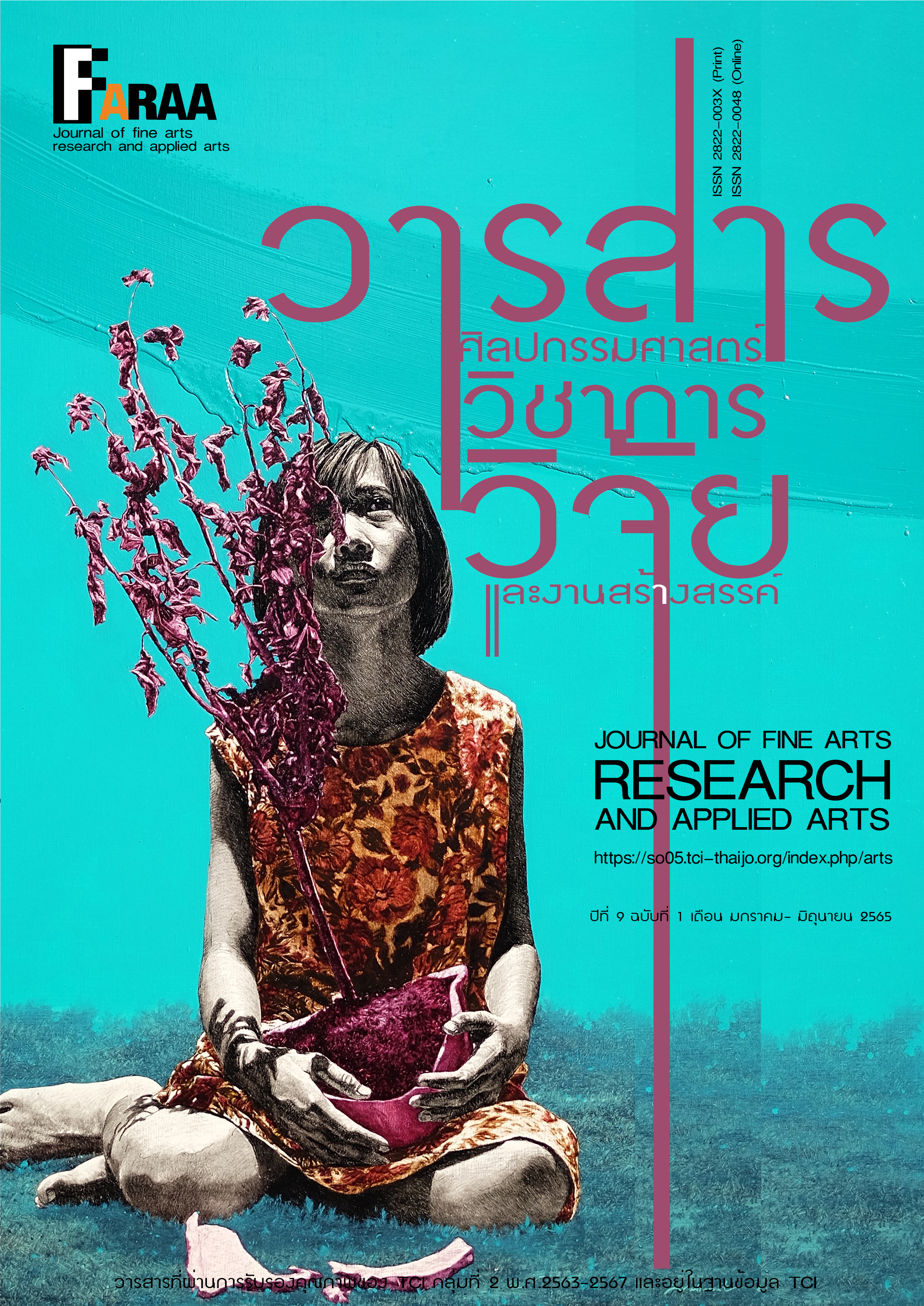Eco-friendly product design factor from water hyacinth combined with wet waste
Keywords:
design factor, design Environmentally, design factor: design Environmentally: friendly products: water hyacinth: wet waste, water hyacinth, wet wasteAbstract
The research is objective. 1) to develop the process of transforming water hyacinths into organic plant pots. 2) to determine the design factor of an organic potted plant from water hyacinth. 3) To assess the satisfaction of the newly developed organic potted hyacinth products, Mixed Methods Research, the first step to developing the water hyacinth transformation process, is tested for N, P, K, pH, EC, moisture, GI in an accredited laboratory. The second step to determining the design factor and assessing satisfaction was the demographic group, namely, shoppers at the Chatuchak Market. 1,124 people in the ornamental flower zone and 150 people who are interested in environmentally-friendly potted products who choose to buy products at the flower decoration area in the Chatuchak market, using Simple Random Sampling at a confidence level of 10.0% of Taro Yamane The research tool used a structured questionnaire. The 5-level rating scale of the liqueur appeared to have Cronbach's Alpha = 0.815 and 0.839. The result of the first step was the highest efficiency formula of the third ingredient. Phosphorus (P205) accounts for 0.89%, potassium (K20) accounts for 0.71%, calcium (CaO) accounts for 2.23%, magnesium (MgO) accounts for 0.37%, and organic matter accounts for 33.76%. By analyzing variable grouping (EFA), affirmative component analysis (CFA), and multiple linear regression, 12 components were correlated from 39 select variables, with Chi-Square = 2076.222 and Sig. =.00, in which 39 factor variables are related. and examine the corroborating elements of the factors affecting product purchases. It confirms the model for measuring the feeling variables, the product appearance factor, the environmental awareness factor (awareness), and the product price factor (price), are consistent with the historical data. = 33.185, df = 27, relative
= 1.229, p =.191, RMSEA =.039, RMR =.025, GFI =.965, AGFI =.900, NFI =.953, TLI =.977, and consumer satisfaction was Sig. .05. The raw score prediction equation was
=1.493+.187(X1)+ .306(X2)+ .270(X3), while the standard score prediction equation was Z=.296(X1)+ .316(X2)+ .312(X3)
References
กัลยา วานิชย์บัญชา. (2546). วิเคราะห์สถิติชั้นสูงด้วย SPSS for Windows. สำนักพิมพ์ ธรรมสาร.
ทรงวุฒิ เอกวุฒิวงศา, สมชาย เซะวิเศษ และสุเมธ ตรีศักดิ์เสธ. (2565). การพัฒนากระบวนการแปรสภาพผักตบชวาร่วมกับขยะเปียกสู่ผลิตภัณฑ์กระถางรักษ์สิ่งแวดล้อม เพื่อตอบสนองความปกติใหม่ (รายงานผลการวิจัย). กรุงเทพฯ: สถาบันเทคโนโลยีพระจอมเกล้าเจ้าคุณทหารลาดกระบัง.
บุญชม ศรีสะอาด. (2543). การวิจัยทางการวัดผลและประเมินผล. สำนักพิมพ์ สุวีริยาสาส์น.
พูลพงศ์ สุขสว่าง. (2557). วิเคราะห์โมเดลสมการโครงสร้าง. วารสารนราธิวาสราชนครินทร์, 6(2), 136-145.
วิรัช วรรณรัตน์. (2538). วิเคราะห์ตัวประกอบ (Factor analysis), วารสารการวัดผลการศึกษา. 48(1), 37-42.
ศิริชัย พงษ์วิชัย. (2544). วิเคราะห์ข้อมูลสถิติ. สำนักพิมพ์แห่งจุฬาลงกรณ์มหาวิทยาลัย.
สุชาติ ประสิทธิ์รัฐสินธุ์. (2540). เทคนิคการวิเคราะห์ตัวแปรหลายตัวสำหรับการวิจัยทางสังคมศาสตร์และพฤติกรรมศาสตร์. โรงพิมพ์ เลี่ยงเชียง.
A. Borowik, J. Wyszkowska. (2016). Soil moisture as a factor affecting the microbiological and biochemical activity of soil. Plant Soil
Environ, 62(6), 250–255.
Aboulam, S., Morvan, B. & Revel, J-C. (2006). Use of a Rotating-Drum Pilot Plant To Model the Composting of Household Waste On an Industrial Scale. Compost Science & Utilization, 14(3), 184-190.
Dahmani, N., Belhadi, A., Benhida, K., Elfezazi, S., Touriki, F. E. & Azougagh, Y. (2022). Integrating lean design and eco-design to improve product design: From literature review to an operational framework. Energy & Environment, 33(1),189-219
.
Diamantopoulos, A. & Siguaw, J. A., (2000). Introduction to LISREL: A guide for the uninitiated. SAGE Publications, Inc,.
Egwutvongsa, S. (2021). Influence Factors on Industrial Handmade Products Designed from Sugar Palm Fibers. Strategic Design Research Journal. 14(2), 456-470.
Egwutvongsa, S. & Seviset, S. (2021). Ideas for Creation: A Comparison of the Learning Results of Three-Dimensional Images between Active Learning and Child-Centered Education of Product Design Students. International Journal of Emerging Technologies in Learning, 16(11), 273-288.
Felix, R., González, E. M., Castaño, R., Carrete, L. & Gretz, R. T. (2022). When the green in green packaging backfires: Gender effects and perceived masculinity of environmentally friendly products. International Journal of Consumer Studies, 46(3), 925-943.
Graedel, T. E., Comrie, P. R. & Sekutowski, J. C. (1995). Green product design. AT&T Technical Journal, 74(6), 17-25.
Habte, M. & Alexander, M. (1977). Further evidence for the regulation of bacterial populations in soil by protozoa. Archives of Microbiology, 113, 181–183.
Holliman, A., Thomson, A., Hird, A. & Wilson, N. (2019). A Matter of Factor: A Proposed Method for Identifying Factors that Influence Design Effort Levels in Product Design. Proceedings of the Design Society International Conference on Engineering Design, 1(1), 1025-1034.
Kaplan, D., (2000). Structural Equation Modeling. Sage Publications, Thosand Oaks.
Karakolidis, A., Pitsia, V., & Emvalotis, A., (2016). Examining students’ achievement in mathematics. International Journal of Educational Research. 79, 106-115.
Kelloway, E. K. (1998). Using LISREL Structural Equation Modeling, Sage Publications.
Lim, C., Kim, KH., Kim, MJ. et al. (2019). Multi-factor service design: identification and consideration of multiple factors of the service. Service Business, 13(1), 51–74.
Maher, M. L., Balachandran, M. B. & Zhang, D. M. (1995). Case-Based Reasoning in Design. Psychology Press.
Nasimi, G. E., Saleh, S. G. & Humbatova, S. I. (2021). Design as a Factor in the Development of a Country's Economy, Research in World Economy, 12(1), 82-89.
Saraf, C., Agrawal, S., Barodiya, D., Shrivastava, P. & Verma, T. N. (2022). AHP-based Identification of Tools for Sustainable Product Development. Advancement in Materials, Manufacturing and Energy Engineering, 3, 543-552.
Schumacker, R. E.,& Lomax, R. G., (2010). A beginner’s guide to structural equation modeling. Lawrence Erlbaum Associates.
Tenko.R., & Marcoulides, G. A. (2006). A first course in structural equation modeling. (2nd Edition). Lawrence Erlbaum Associates.
Zhu, W. & He, Y. (2017). Green product design in supply chains under competition. European Journal of Operational Research, 258(1), 165-180.
Downloads
Published
How to Cite
Issue
Section
License
Copyright (c) 2022 Journal of fine arts research and applied arts

This work is licensed under a Creative Commons Attribution-NonCommercial-NoDerivatives 4.0 International License.



